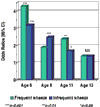Pathophysiological mechanisms for the respiratory syncytial virus-reactive airway disease link
- PMID: 12119054
- PMCID: PMC1866371
- DOI: 10.1186/rr185
Pathophysiological mechanisms for the respiratory syncytial virus-reactive airway disease link
Abstract
There is substantial epidemiological evidence supporting the concept that respiratory syncytial virus (RSV) lower respiratory tract infection in infancy may be linked to the development of reactive airway disease (RAD) in childhood. However, much less is known concerning the mechanisms by which this self-limiting infection leads to airway dysfunction that persists long after the virus is cleared from the lungs. A better understanding of the RSV-RAD link may have important clinical implications, particularly because prevention of RSV lower respiratory tract infection may reduce the occurrence of RAD later in life. Among the mechanisms proposed to explain the chronic sequelae of RSV infection is the interaction between the subepithelial neural network of the airway mucosa and the cellular effectors of inflammatory and immune responses to the virus. The body of clinical literature linking RSV and RAD is reviewed herein, as are the cellular and molecular mechanisms of neuroimmune interactions and neural remodeling that may underlie this link, and the possibility that preventing the infection may result in a decreased incidence of its chronic sequelae.
Figures


References
-
- Centers for Disease Control and Prevention Respiratory syncytial virus activity: United States, 1999–2000 season. MMWR Morb Mortal Wkly Rep. 2000;49:1091–1093. - PubMed
-
- McConnochie KM, Roghmann KJ. Bronchiolitis as a possible cause of wheezing in childhood: new evidence. Pediatrics. 1984;74:1–10. - PubMed
Publication types
MeSH terms
LinkOut - more resources
Full Text Sources
Medical

